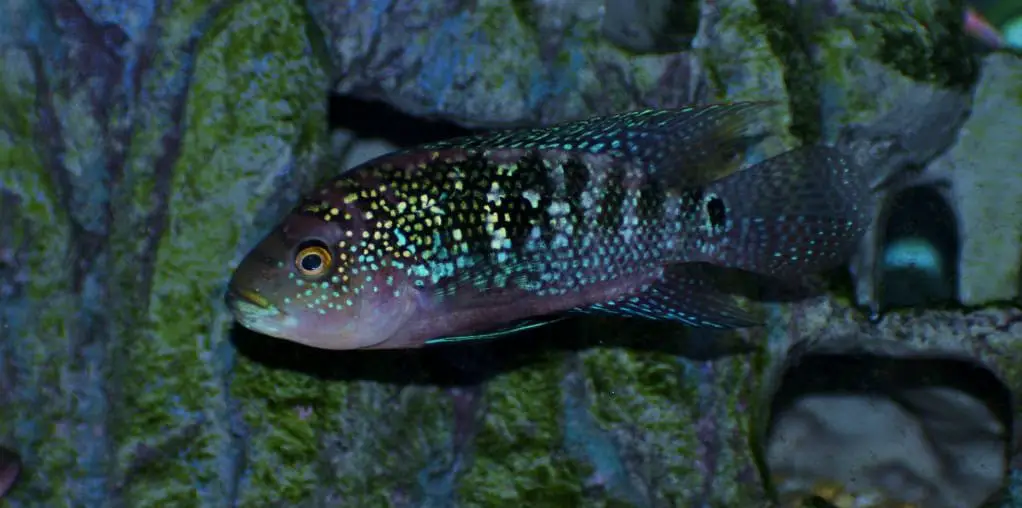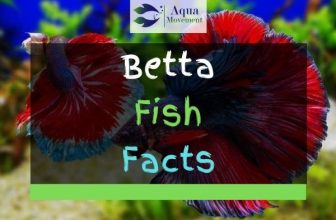15 Best Oscar Fish Tank Mates (With Pictures)
The Oscar Fish (Astronotus ocellaturs) is popular. Fish Keeper’s like the Oscar because it is very active and comes in different varieties.
The Oscar Fish is a ruthless predator. This is very true if it’s living on its natural habitat in the Amazon. This is the reason why raising Oscar Fish requires considerable investment for food and tank maintenance.
There at least 10 different varieties of Oscar Fish. The color of the Oscar Fish varies per species. In the market, you may find yellow oscar fish, red oscar fish, black oscar fish, etc.
Regardless of its variety, the Oscar Fish never fails to display aggressive behavior.
Raising an Oscar Fish isn’t for beginners. If you’re planning to raise one, adequate preparedness and knowledge are required.
One of the basic requirements of raising Oscar Fish is knowing about the fishes that go along with it. This article will present you with 15 of the best Oscar fish tank mates.
Finish reading this article until the end because I’ll be giving a few tips on building an Oscar Fish community tank.
Table of Contents
Jaguar Cichlid

Gunther described the existence of the Jaguar Cichlid (Parachromis managuensis) in 1867.
The Jaguar Cichlid happily dwells in the Ulua River in Honduras and Matina River in Costa Rica.
Nature imbued the Jaguar Cichlid with a striking pattern consisting of black and white colors. Most Jaguar Cichlids grow up to 24 inches.
Still, it’s possible to find bigger ones in the wild.
Communities living near Jaguar Cichlid habitats consider Jaguar Cichlids as a delicacy. Some people resort to eating them because Jaguar Cichlids multiply quickly and become parasitic.
The Jaguar Cichlid is a bit aggressive. However, it goes along with other Cichlids and Oscar Fish.
You need a large tank, moderate lighting, gravel substrate, and lots of tank ornaments for raising Jaguar Cichlid with Oscar Fish.
Jaguar Cichlid Profile
- Other Names: Managua Cichlid, Managuense Cichlid, Aztec Cichlid, and Guapote
- Life Span: 15 Years
- Diet: Earthworms, Tadpoles, Crickets, Fish Flakes, and Brined Shrimps
- Preferred Water Condition: Non-Acidic, Warm (25-36 degrees Celsius)
- Minimum Tank Requirement: 125 Gallons
- Suitable Tank Mates: Oscar Fish, Redtail Catfish, Green Terror Jack Dempsey, Sailfin Pleco, and Giant Gourami
Green Terror Cichlid
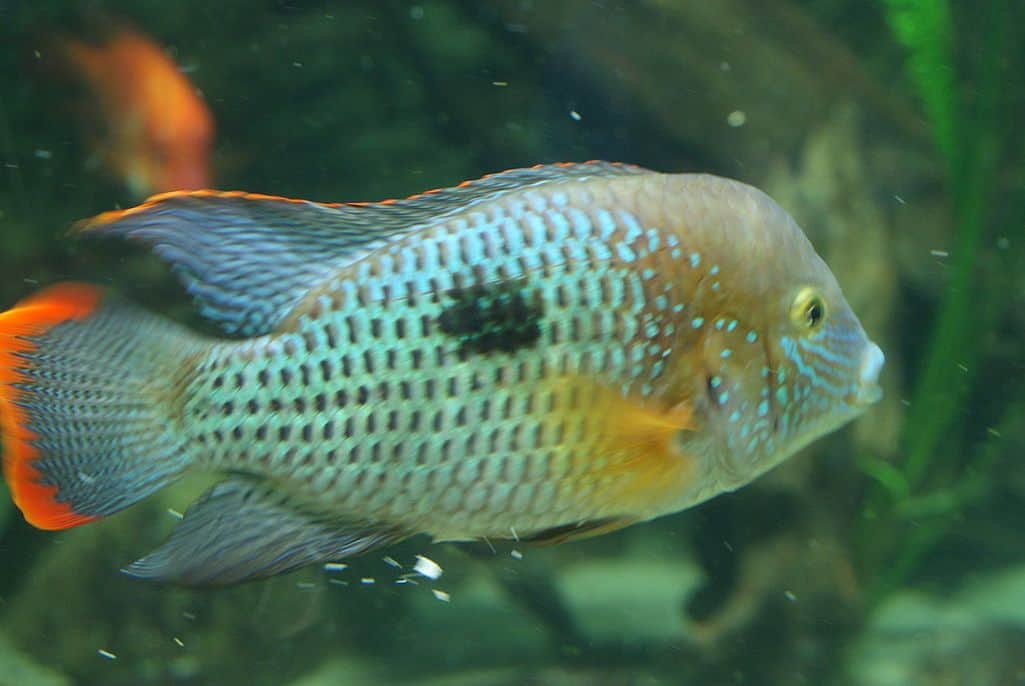
Gunther described the Green Terror Cichlid (Andinoacara rivulatus) in 1860. This fish originally comes from the coastal waters of South America, Peru, and Western Ecuador.
Contrary to its name, the Green Terror Cichlid isn’t green. Hence, it has a bright blue-green and black coloration. Some may even have a slight hue of yellow on the fins and tail.
Female Green Terror Cichlid may reach a maximum size of 8 inches. The male, on the other hand, may reach 12 inches.
This fish is more attractive than the Jaguar Cichlid. However, it might be more aggressive.
To raise Green Terror Cichlid, you need lots of community tank ornamental mini caves, aquatic plants, and substrates such as rocks, sand, and small pieces of wood.
Green Terror Cichlid Profile
- Other Names: Andinoacara rivulatus
- Life Span: 10 Years
- Diet: Freeze-dried bloodworms, Tubifex, Ocean Plankton, and Cichlid Pellets
- Preferred Water Condition: Mildly Acidic, Warm (25-26 degrees Celsius)
- Minimum Tank Requirement: 75 Gallons
- Suitable Tank Mates: Oscar Fish, Firemouth Cichlid, Silver Dollar Fish, Clown Pleco, and Bristlenose Pleco
Sailfin Pleco
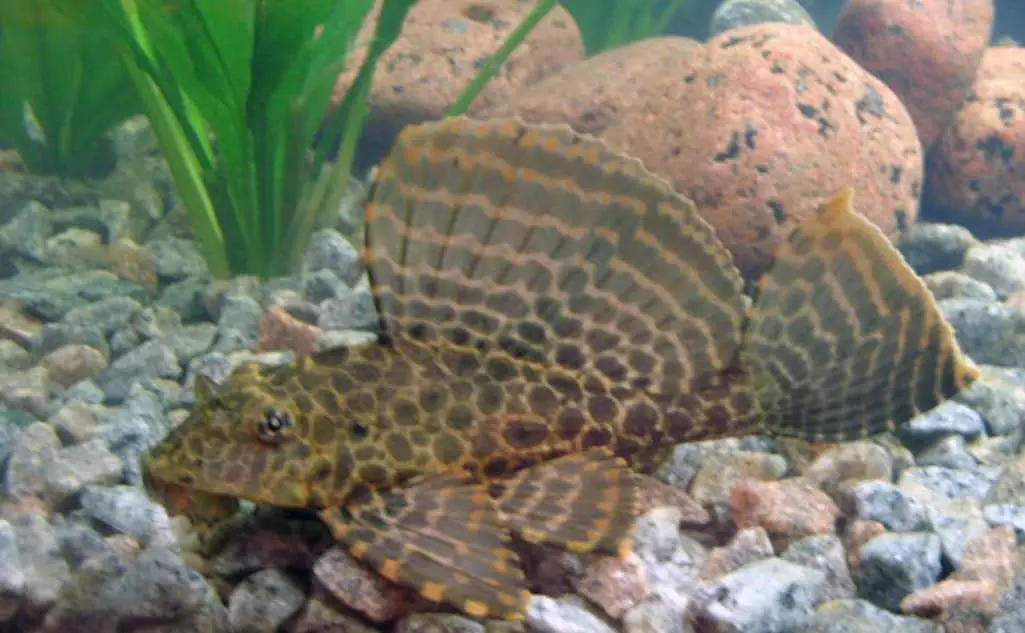
Kner scientifically announced the existence of Sailfin Pleco (Pterygoplichthys gibbiceps) in 1845. It’s a fish that’s endemic to Rio Pacaya, Peru.
However, Sailfin Pleco is scattered throughout South America right now due to breeding.
The Sailfin Pleco has a dark brown color. This makes the patterns on its body highly noticeable. The “Sailfin” on its name might have been derived from the large dorsal fin, pectoral fins, and pelvic fins that it has.
Male Sailfin Pleco has an average size of 19.7 inches. The same might be also true for females.
The Sailfin Pleco is more active at night. Thus, you shouldn’t opt to install a lot of lighting when raising this fish with Oscar Fish.
Furthermore, it’s not very aggressive but you should be careful when it’s spawning.
Sailfin Pleco Profile
- Other Names: Leopard Plecostomus, Leopard Pleco, Clown Pleco, Spotted Sailfin Pleco, and Clown Sucker Catfish
- Life Span: 15 Years
- Diet: Freshwater Algae, and Detritus
- Preferred Water Condition: Slightly Alkaline, Warm (23-26 degrees Celsius)
- Minimum Tank Requirement: 100 Gallons
- Suitable Tank Mates: All Aquatic Animals Not Bigger Than Sailfin Pleco
Common Pleco
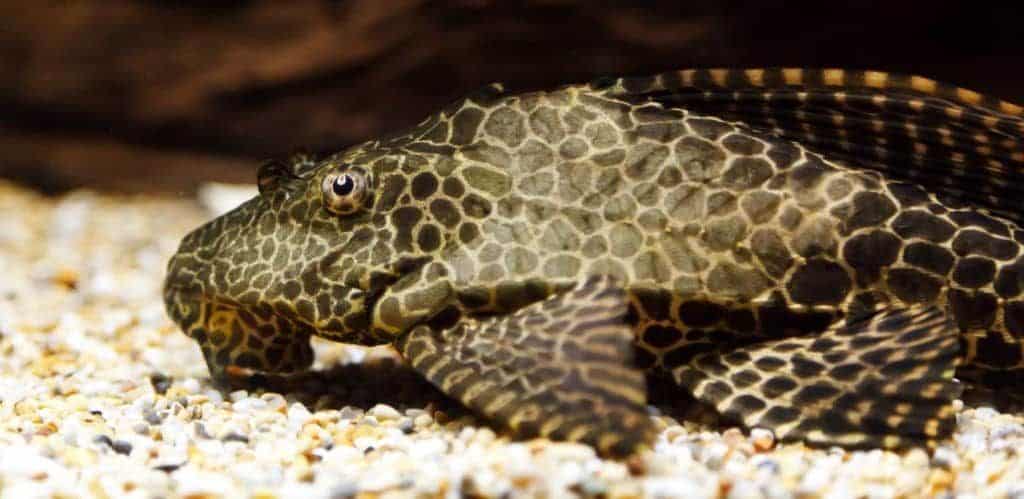
The first official specimen of the Common Pleco (Hypostomus Plecostomus) was caught in the headwaters of the San Antonio River, Texas during 1962.
However, the existence of Common Pleco was reported as early as 1983 in Nevada. Still, verification shows that the specie reported in Nevada was not the Common Pleco but was another type of fish.
The Common Pleco has brown or black-spotted coloration. This is one of the best Oscar fish tank mates that resemble the Sailfin Pleco.
Wild Common Pleco may reach up to 24 inches. On the other hand, tank raised Common Pleco only reaches a maximum size of 15 inches.
The Common Pleco loves to swim on the bottom. This is why you should consider having a good substrate when raising this fish with the Oscar fish.
Furthermore, it’s not very active on very bright community tanks. Thus, you have to avoid putting very luminous lighting.
Common Pleco Profile
- Other Names: Suckermouth Catfish
- Life Span: 15 Years
- Diet: Freshwater Algae, Detritus
- Preferred Water Condition: Slightly Alkaline. Warm (23 degrees Celsius)
- Minimum Tank Requirement: 100 Gallons
- Suitable Tank Mates: Oscar Fish, Angel Fish, Neon Tetra, Hatchet Fish, and Silver Dollar
Silver Dollar

The Silver Dollar (Metynnis Argenteus) originates from the Tapajos River in Brazil. Many say that it’s endemic to the Tapajos.
However, this claim might not be true because the Silver Dollar is also found in the waterways of Guyana and Peru.
True to its name, this fish looks very silvery in many aspects. The Silver Dollar is very striking on well-lighted tanks because it shines.
The attractiveness of this fish is further reinforced by its behavior of swimming in schools consisting of 6 members.
The Silver Dollar may reach a maximum size of 20 centimeters.
Fishkeepers treat the Silver Dollar as semi-aggressive. Nevertheless, most are mellow and happily interact with other fish on the community tank.
Silver Dollar Profile
- Other Names: None
- Life Span: 10 Years
- Diet: Lettuce, Cress, Spinach, Cucumber, and Spring Greens
- Preferred Water Condition: Slightly Acidic or Neutral, Warm (23-27 degrees Celsius)
- Minimum Tank Requirement: 75 Gallons
- Suitable Tank Mates: South and Central American Cichlids (Peaceful), Freshwater Angel Fish, and Giant Danios
Firemouth Cichlid

The Firemouth Cichlid (Thorichthys meeki) is a specie of Cichlid that’s native to Central America.
Specifically, it’s natural habitat is the rivers of Yucatan Peninsula, Usumacinta Basins of Mexico and Guatemala, and Lago de Ilusiones.
The Firemouth Cichlid reached Florida in the 1960s and other neighboring states through aquarium release or deliberate introduction.
Right now, the Firemouth Cichlid dwells on various bodies of water within the United States.
The coloration of the Firemouth Cichlid is very unique. It has a gray or yellowish scale with a slight reddish hue on the underside that spans from the tail to the head. Furthermore, there’s also a black patch near its tail and fins.
Fishkeepers recommend male Firemouths because their color is more vibrant.
Firemouth Cichlid might be one of the most expensive best Oscar fish tank mates. Two Firemouths are sold at $19.99
The Firemouth Cichlid may grow a maximum of 6 inches and males might be larger than females.
Firemouth Cichlid Profile
- Other Names: Firemouth, Red-breasted Cichlid, and Mojarra Boca De Fuego
- Life Span: 8 Years
- Diet: Freeze-Dried Bloodworms, Tubifex, Ocean Plankton, and Cichlid Pellets
- Preferred Water Condition: Slightly Acidic or Acidic, Warm (23 – 30 degrees Celsius)
- Minimum Tank Requirement: 30 Gallons
- Suitable Tank Mates: Oscar Fish, Rummy Nose Tetras, Glowlight Tetras, and Pictus Catfish
Severum Cichlid
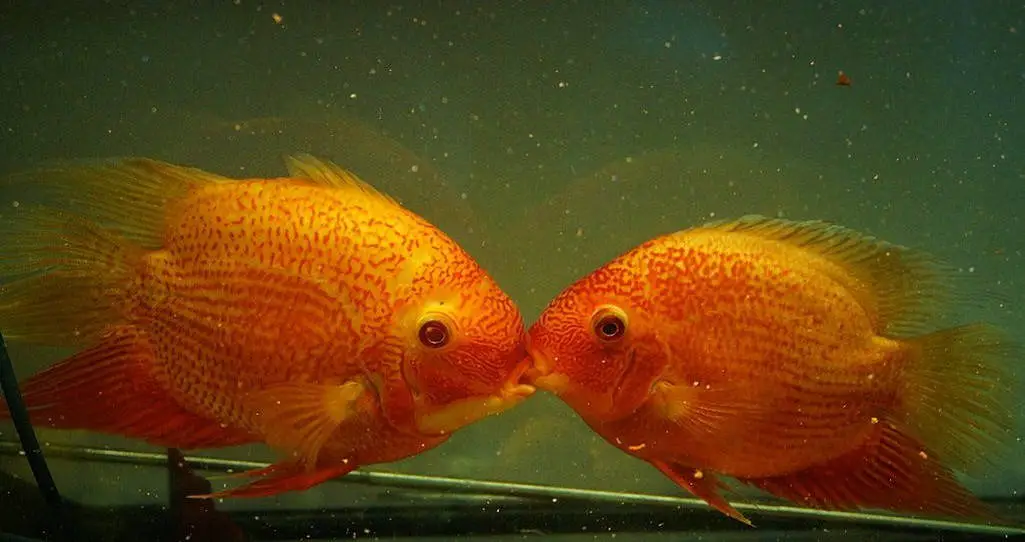
Heckel recognized the existence of this fish in 1840.
The Severum Cichlid (Heros severus) originally dwelled in the upper portions of Orinoco and Rio Negro basins in South America.
Fishkeepers love Severum Cichlid for its noticeable color. Nature imbued this fish with bright golden color from head to toe.
As a result, Severum Cichlid looks beautiful even if the fish tank doesn’t have a lot of lightings.
Severum Cichlid can grow up to 8 inches. This is the case for males and females.
The Severum Cichlid is docile most of the time. However, it becomes very aggressive when spawning and might kill other fish in the tank to protect its eggs.
Severum Cichlid Profile
- Other Names: Convict Fish, Deacon, Sedate Cichlid, Golden Cichlid, and Striped Cichlid
- Life Span: 10 Years
- Diet: Freeze-Dried Bloodworms, Cichlid Pellets, Ocean Plankton, Brined Shrimps, and Fish Flakes
- Preferred Water Condition: Brackish Freshwater, Neutral Water, Soft Water; Warm (25-27 degrees Celsius)
- Minimum Tank Requirement: 40 Gallons
- Suitable Tank Mates: Oscar Fish, Plecos, Similar Sized Cichlids, and Scavenger Catfish
Jack Dempsey Cichlid
Jack Dempsey Cichlid (Rocio octofasciata) is a species of Cichlid that originates from North and South America.
This fish is named after the world heavyweight champion Jack Dempsey (1919-1926) due to its very aggressive behavior.
The Jack Dempsey has two gray-black colorations on the top of its head. The base color of this fish is a dark blue that’s mixed with white or blue spots.
Furthermore, the sides of its body might also have black patches or bars.
This fish is certainly aggressive. However, it only attacks other fish when defending its territory. This is why you shouldn’t put a lot of Jack Dempseys in a community tank.
You may also opt to use a very spacious community tank if you choose to raise a lot of Jack Dempseys with your Oscar Fish.
Jack Dempsey Cichlid Profile
- Other Names: None
- Life Span: 10 Years
- Diet: Grubs, Worms, Brine Shrimps, and Tiny Bits of Meat
- Preferred Water Condition: Acidic, Warm (25-26 degrees Celsius)
- Minimum Tank Requirement: 80 Gallons
- Suitable Tank Mates: Oscar Fish, Clown Loach, Goldfish, Rasboras, Angel Fish, and Cascarudo
Bichir
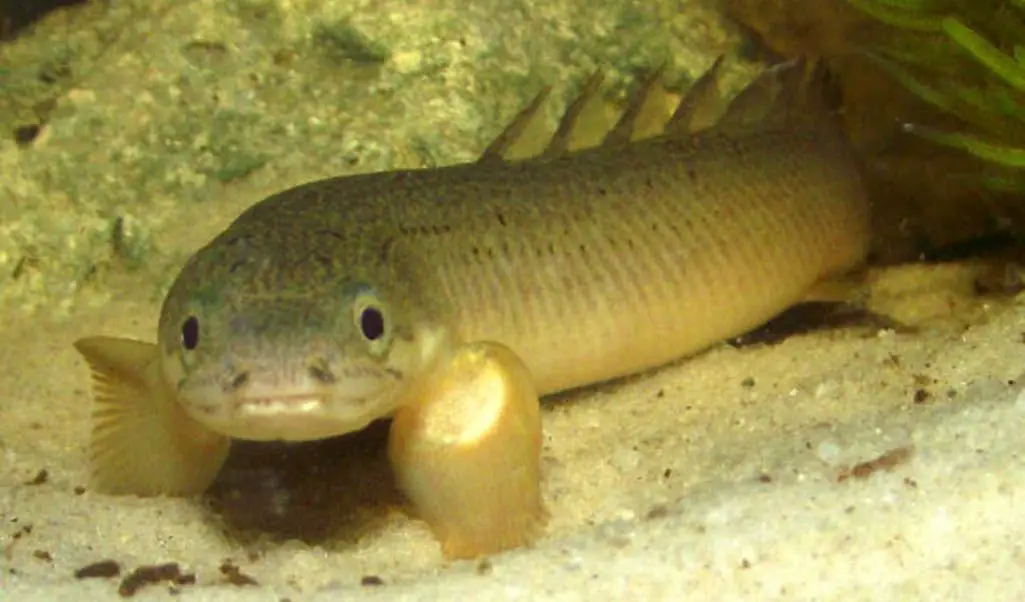
The Bichir is an air-breathing tropical fish that’s native to western and central Africa. There are about 10 varieties of this fish today.
Out of all types of Bichir, the Saddled Bichir is most ideal for community tanks. The second in rank is the Gray Bicher.
Lastly, you may opt to raise the Congo Bicher if the Saddled Bichir and Gray Bichir doesn’t suit your taste.
Depending on its specie, a Bichir may grow up to 23.6 inches or 29.5 inches.
The Bichir is a merciless predator. However, it only targets smaller fishes. Thus, you have to separate baby Oscar Fishes from the community tank if you decide to raise Bichir too.
Bichir Profile
- Other Names: Varies Per Specie (Senegal Bichir, Congo Bichir, Saddled Bichir, etc.)
- Life Span: 20 Years
- Diet: Bloodworms, Frozen Shrimps, Small Pieces of Meat, and Earthworms
- Preferred Water Condition: Neutral, Warm (76-86 Degrees Fahrenheit)
- Minimum Tank Requirement: 90 Gallons
- Suitable Tank Mates: Oscar Fish, Blood Parrot, Flowerhorn, Knifefish, and Catfish
Chocolate Cichlid
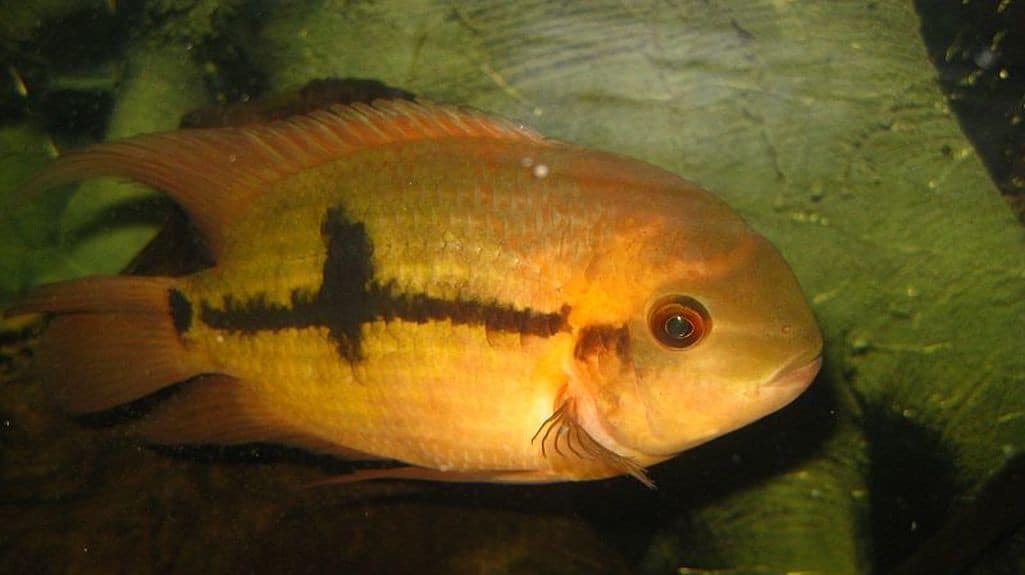
The Chocolate Cichlid (Hypeselecara temporalis) comes from South America. In the wild, it prefers slow-moving waters with heavy vegetation as a habitat.
Some hotspots for Chocolate Cichlid are Lake Saraca and Hyutay River.
The eyes of Chocolate Cichlid are very unique. They might be colored amber-gold or bright red. Furthermore, it’s body features a mustard-yellow hue with black markings on each side.
This is fish grows up to 30 inches. Chocolate Cichlid is highly active and happily swims on the tank with or without lots of ornamental accessories.
Chocolate Cichlid is one of the best Oscar fish tank mates that are very easy to raise and take care of.
Chocolate Cichlid Profile
- Other Names: Emerald Cichlid
- Life Span: 8 Years
- Diet: Small Ghost Shrimp, Daphnia, Pellets, Fish Flakes, and Blanched Vegetables
- Preferred Water Conditions: Soft Water, Warm (23-29 degrees Celsius)
- Minimum Tank Requirement: 75 Gallons
- Suitable Tank Mates: Oscar Fish, Cyprinids, Catfish, and Characins
Blue Acara
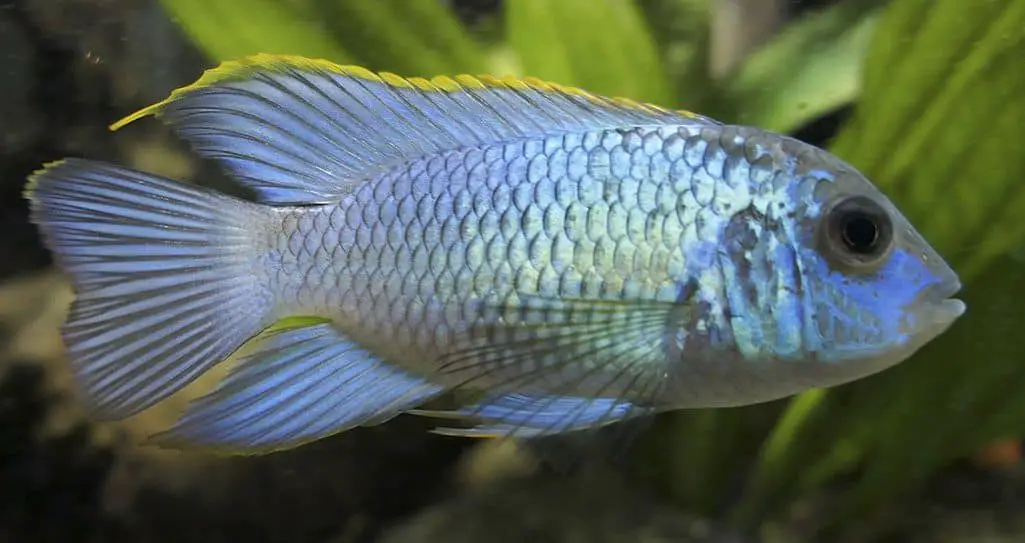
The original habitat of the Blue Acara (Andinoacara Pulcher) is the non-rapid rivers and lakes of Central and South America.
The Blue Acara is a very popular specie of Cichlid because it’s beautiful and easy to raise.
The Blue Acara has a bright blue color which is very noticeable on community tanks with moderate lighting.
Sometimes its body is also filled with black or white patterns. Lastly, a set of greenish markings might also appear on its face.
This fish may grow a maximum of 5 inches.
The Blue Acara isn’t aggressive. However, it’s very territorial and won’t hesitate to attack other fish in the community tank that invades its space.
Blue Acara Profile
- Other Names: None
- Life Span: 10 Years
- Diet: Earthworms, Brined Shrimps, Bloodworms, and Small Insects
- Preferred Water Conditions: Slightly Alkaline, Warm (23 – 24 degrees Celsius)
- Minimum Tank Requirement: 30 Gallons
- Suitable Tank Mates: Oscar Fish, Cory Fish, Discus Fish, Rainbow Fish, and Bristlenose Pleco
Arowana
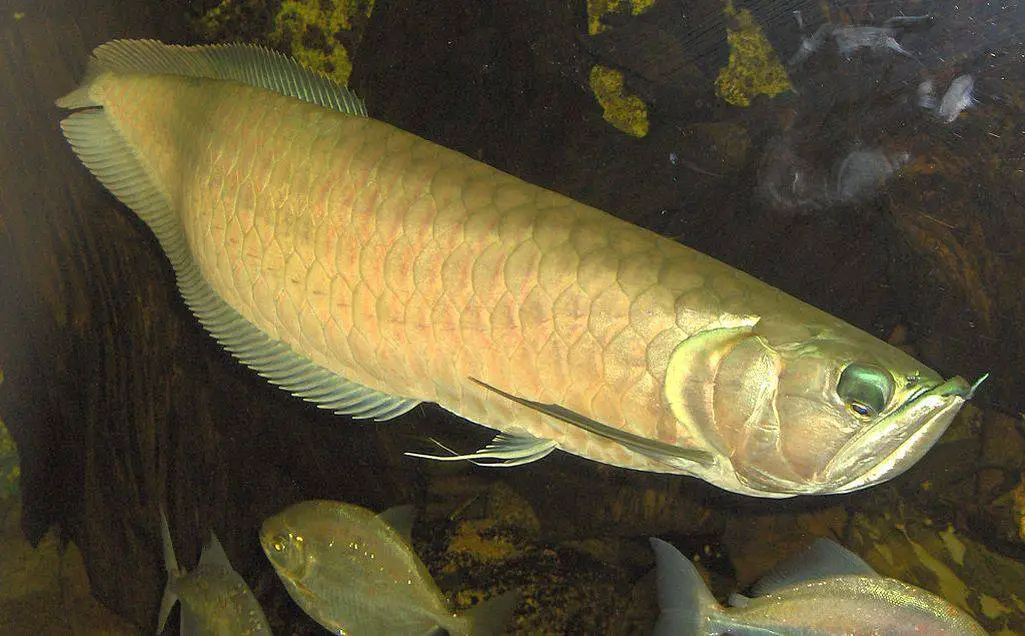
The Arowana (Osteoglossidae) comes from Southeast Asia. It’s one of the most expensive fish for fish tanks to date.
To give you an idea, a single Arowana might be sold for $300,000.
The Arowana comes in different colors. There are yellow Arowana, Black Arowana, Red Arowana, and Silver Arowana.
In fish tanks, the maximum size of the Arowana is only 3 feet. However, it can reach up to 4 feet on its natural habitat.
The Arowana is very territorial. You should opt to buy a very large community tank if you opt to raise this with your Oscar Fish.
Also, try to put a lot of hiding places so that smaller fish can avoid getting attacked by the Arowana.
Arowana Profile
- Other Names: Asian Bonytongue, Dragonfish,
- Life Span: 15 Years
- Diet: Smaller Live or Frozen Fish, Krills, Shrimps, Pellets, and Worms
- Preferred Water Conditions: Neutral Water, Soft Water, Warm (30 degrees Celsius)
- Minimum Tank Requirement: 150 or 200 Gallons
- Suitable Tank Mates: Oscar Fish, Clown Loach, Snakehead Fish, Tiger Datnoid, and Knife Fish
Demon Earth Eater
The Demon Earth Eater (Satanuperca jurupari) is a fish that’s native to the Amazon River basin from Peru, Ecuador, and Colombia extending to the entrance of the Amazon River in Brazil.
This fish has a base color of tan or green. Its scales might have a golden or greenish hue. Furthermore, it’s translucent fins might also feature various markings.
Contrary to its name, the Demon Earth Eater is peaceful. It doesn’t attack other fishes unless provoked.
It happily swims around the community tank to look for food or explore.
Demon Earth Eater Profile
- Other Names: Jurupari Earth Eater
- Life Span: 8 Years
- Diet: Baby Brine Shrimps, and Crushed Fish Flakes
- Preferred Water Conditions: Acidic, Warm (30 degrees Celsius)
- Minimum Tank Requirement: 55 Gallons
- Suitable Tank Mates: Oscar Fish, Tetras, Characins Loricarids, Cory Fish, Angel Fish, Severum Fish, and Rasboras
Convict Cichlid

The Convict Cichlid (Amatitlania nigrofasciata) is native to Central America.
In the wild, it prefers habitats that feature moderate rapids with lots of rocks, branches, and other debris that may act as cover.
This fish is popular among fishkeepers due to its striking pattern. The Convict Cichlid features black lines on both sides of its body that are contrasted by its white base color.
The coloration of Convict Cichlid makes it very suitable for bright to moderately lighted fish tanks.
When raising Convict Cichlids with Oscar Fish, be sure to put lots of large aquatic plants because they love to swim around these.
Don’t forget to put a gravel substrate when raising Convict Cichlid.
Convict Cichlid Profile
- Other Names: Zebra Cichlid
- Life Span: 8 Years
- Diet: Freeze-Dried Bloodworms, Tubifex, Ocean Plankton, Cichlid Pellets
- Preferred Water Conditions: Neutral or Slightly Alkaline, Warm (26 – 72 degrees Celsius)
- Minimum Tank Requirement: 30 Gallons
- Suitable Tank Mates: Oscar Fish, Pictus Fish, Jack Dempsey Fish, and Clown Loach
Banded Leporinus

Bloch scientifically described the Banded Leporinus (Leporinus fasciatus) in 1794. This fish is native to the Amazon River basin that stretches from Brazil, Colombia, and Venezuela.
This fish has a streamlined shape that greatly resembles a torpedo. Its coloration is a bit similar to the Black Convict Cichlid.
However, the base color of the Banded Leporinus is a combination of yellow and black.
The Banded Leporinus loves to swim in schools consisting of 10 members. It loves to graze on the bottom of the fish tank feeding on algae.
When algae are not present, the Banded Leporinus turns its attention on the leaves of aquatic plants instead.
Banded Leporinus Profile
- Other Names: Black Banded Leporinus
- Life Span: 10 Years
- Diet: Algae, Chickweed, Lettuce, and Peas
- Preferred Water Conditions: Neutral or Slightly Alkaline, Warm (22 – 26 degrees Celsius)
- Minimum Tank Requirement: 50 Gallons
- Suitable Tank Mates: Characins, Loricariids, Similar Sized Cichlids, and Doradids
Tips For Making Oscar Fish Community Tank
The fishes that I mentioned above are the most ideal for an Oscar Fish community tank. Now that we’re done talking about them.
Allow me to give you a few tips on building an Oscar Fish community tank before this article ends.
Stick to the 150 Gallons Minimum Requirement
The Oscar Fish and its best buds love spacious tanks. Furthermore, they easily get deprived of oxygen. This is why you should opt to get a tank that can contain 150 gallons of water.
A 150 gallons tank ensures that the Oscar Fish and its tank mates have enough oxygen. Furthermore, it averts them from experiencing stress.
However, you might need a bigger tank if you decide to raise Oscar Fish with Arowana. Arowana is a big fish and you have to get a tank that can accommodate its size.
Stick To 5 or 10 Fishes Only
For community tanks, keeping 10 Oscar Fish will do. This rule also applies to its tank mates. Avoid putting too much because the Oscar Fish and its tank mates are highly territorial.
The least that you want to happen is the Oscar Fish and its companions fighting for territory inside the community tank.
Put Lots of Aquatic Plants and Ornaments
Oscar Fish loves to hide sometimes. The same is also true for the best Oscar fish tank mates that I presented.
This is why you should put lots of aquatic plants and ornaments that can serve as a cover or hiding spots in the Oscar Fish community tank.
Plants that you can add is floating water moss, Amazon sword, and Crypt Wendtii. On the other hand, ideal ornaments are toy caves, driftwood, and small to medium-sized rocks.
Make It Gender Exclusive
Oscar Fish and its tank mates become aggressive when spawning. This is why you should avoid putting females if you’re not planning on breeding fish in the community tank.
A gender-exclusive community tank is possible. However, you should expect the fishes inside to exhibit unusual behaviors.
Conclusion
Though aggressive, Oscar Fish is easy to raise. That’s why you shouldn’t hesitate to make an Oscar Fish community tank. All you need to do is familiarize yourself with the basic requirements and you’re good to go.
All the fishes that I presented are the most compatible for Oscar Fish. Just like the Oscar Fish, they’re very easy to raise and are very affordable.
The Arowana is an exception though. Raising it with Oscar Fish needs hefty investment and a considerable amount of knowledge
The investment for an Oscar Fish community tank isn’t cheap. However, successfully making one will give you the joy of observing how moderate-sized fish interact with each other.
Thanks for visiting! Visit again for more discussions about community tanks.

